I recently bought a deep freezer for my apartment. It lives in our guest room along with Tucker’s surf board and tool boxes (#weneedagarage). Buying a deep freezer for a tiny apartment sounds excessive, I know. But it was for good reason.
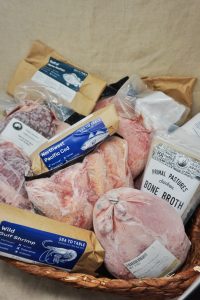
Over the course of the past several months, I’ve read a lot and watched a lot of documentaries about our food system in the US. And with each new piece of information I gather, the more skeptical I become about the food I’m eating. The lack of transparency in our food system is nothing short of a crisis, and I’ve decided to change the way I eat as a result.
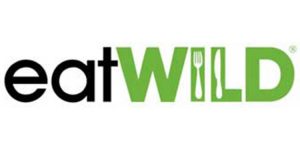
I stumbled upon a website called Eat Wild a couple months ago, which was exactly what I needed as I figured out next steps in making this change.
Eat Wild’s mission is to inform consumers about the importance of eating nutritious, unadulterated meats (and produce), free of hormones, antibiotics, unhealthy diets, and gruesome living conditions. (Note: If you haven’t educated yourself about the “standards” of raising livestock in this country, and the effect it has on the food you eat, you should.)
Eat Wild provides a directory of farmers throughout the US that subscribe to providing consumers with healthy, grass-fed, free-range meats, many of which offer subscription services that will ship the food directly to your door.
Side note: Can you be passionate about supporting local businesses? If so, I am.
This was another major consideration for me as I ventured in the direction of healthier eating. Maybe it’s the wannabe-entrepreneur in me (I’m just waiting for my “ah-ha!” moment, if that’s a thing), but I find it extremely rewarding to be able to support a family business over a big-box store or company.
Eat Wild has identified specific criteria for the farms that are featured in their directory.
The assurance of knowing that each farm I read about met these healthy food standards was encouraging. I spent hours sifting through the farm directory, looking for a farm that met my needs as a consumer.
Here are a few of the criteria that really resonated with me (taken from eatwild.com):
- Animals are raised in a low-stress, natural environment and treated humanely from birth to market.
- Animal grazing patterns are managed to enhance the growth of the pasture, the health of the land, and the nutritional value of products, taking into account the specific soil conditions, vegetation, altitude, growing season, and temperature range of our climate.
- When high-quality pasture is not available, beef and other ruminants (goats, sheep, bison, deer) are fed stored grasses, which can include hay, haylage, and grass silage. They are not fed grain, soy, corn silage, or concentrate.
- Animals are not treated with hormones.
- Animals are not treated with routine, low-level antibiotics. Animals that do receive antibiotics due to health problems or injury are removed from the program.
- Animals are not confined indoors or in areas without pasture except to protect their welfare during brief periods such as prior to and during birthing, or during extreme weather conditions.
If you’re curious about the rest of the Eat Wild criteria, click here to read them all!
My research led me to find that there were several farms that would allow me to purchase meat directly from local farmers in my area.
Honestly, this surprised me a little bit considering I live in the metropolis that is the greater-Los Angeles area. That said, it also showed me that there are no excuses for not subscribing to this healthy lifestyle with all of these options available!
I also expected to have to set aside more of our monthly budget for groceries in order to purchase meat directly from farmers. But, once again, I was surprised to learn that ordering in bulk from these farmers meant I wouldn’t be spending much more than my normal grocery bill. Another reassurance for sure!

The farm I ended up settling on for my meat is called Primal Pastures.
They are based in Temecula, California (fun fact: that’s where Tucker and I got married!), and their box shipments offer a variety of meats in them (which was my personal preference). I appreciated the story of how the founders got into the farming business, and the emphasis on sustainability and responsible farming. For paleo diet fans out there, all of the Primal Pastures meat is paleo-friendly. I ordered the “Cowboy Stash” variety box from them, and here’s what I got in my first shipment:
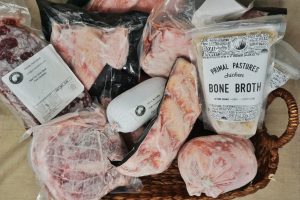
- 1 whole chicken
- 2 packages of chicken bone broth
- 1 package of chicken thighs
- 2 packages of ground white meat chicken
- 1 package of boneless skinless chicken breast
- 2 packages of chicken drumsticks
- 1 (large) package of chicken wings
- 1 package of ground beef
- 1 top sirloin steak
- 1 pork leg roast
- 1 pork shoulder
- 1 large jar of honey from the farm (and it is delicious!)
- 2 cans of wild caught tuna
Altogether, the box weighed about 22 pounds.

Now, as much as I love cooking with meat, I’m also a big seafood fan.
I did some extra digging on my own to find a sustainable, healthy seafood company that would allow the same health benefits that I found with Primal Pastures. Sea to Table was the answer I was looking for. All of their fish is wild caught, traceable, domestic, and sustainable, and is never pumped with hormones or antibiotics. I purchased a box of seafood to round out my stash of protein for the next several weeks. Here’s what came in my first shipment:
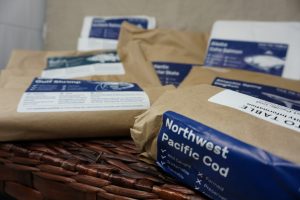
- 2 portions of Alaska Coho Salmon
- 2 portions of Alaska Sockeye Salmon
- 2 portions of Gulf of Maine Redfish
- 2 portions of Atlantic Winter Skate
- 2 portions of Atlantic Spiny Dogfish
- 2 portions of Northwest Pacific Cod
- 2 portions of Wild Gulf Shrimp
So, now you understand why I bought a deep freezer.
I’m looking forward to the challenge of developing recipes with each of these different foods, and hopefully reaping the health benefits in the process. My next step is to identify how I can be purchasing more sustainable produce to round out this newfound passion for healthy eating. Let me know your suggestions in the comments!
If this post made you think twice about the food you’re consuming, I encourage you to dig a little deeper and learn about the flaws within our food system. If you’re inspired to change your eating habits altogether, look into how you can support local farmers or fishermen in your area, and ideally receive better quality food as a result. It is easier than you think, and extremely rewarding to be able to give back to your community. I’ve linked the Eat Wild directory below to give you a head start in finding farms in your area.
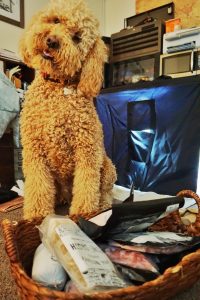
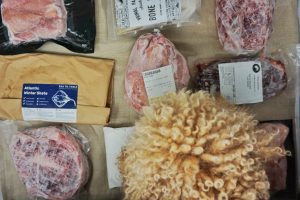
Have you already made the switch to healthy eating? Thinking of making the switch for the first time? Let me know in the comments below!
Happy Healthy Eating!

Informative and very well written with a touch of humor too. Great blog Caitlin Hodges!
Thank you!
I love seafood, so definitely going to be checking out Sea To Table!
Awesome, glad to hear it!
This is most interesting, Caitlin. Poor timing, though. Bob would have eaten everything. Dan is the pickiest eater in Huntington Beach, and your packages are not for single eaters. I am not sure I want to research grocery store offerings. :-} I think you and Tucker are going to have some great meals.
Thanks, Noreen! Yes, buying in bulk can be a challenge. We’ve enjoyed cooking with this food so far, though!
Great post Caiti! Eat Wild is a great resource. Rich and I have been buying from our local farmers and growing our own since we moved here. There is a local fisher woman here who spends every summer catching wild cod and salmon and we buy in bulk when she returns. We had to buy a freezer too!
That’s awesome! It is such a great feeling to know you are eating quality food and supporting local farmers/fishermen, too!